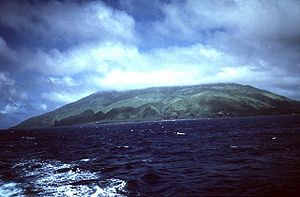Agrihan
 NASA Space Shuttle image of Agrihan | |
 | |
| Geography | |
|---|---|
| Location | Pacific Ocean |
| Coordinates | 18°46′42″N 145°40′17″E / 18.77833°N 145.67139°E |
| Archipelago | Northern Mariana Islands |
| Area | 44.05 km2 (17.01 sq mi)[1] |
| Length | 9 km (5.6 mi) |
| Width | 6 km (3.7 mi) |
| Highest elevation | 965 m (3166 ft) |
| Highest point | Mount Agrihan |
| Administration | |
United States | |
| Commonwealth | Northern Mariana Islands |
| Demographics | |
| Population | 4 (2020) |
Agrihan (also spelled Agrigan) is an island in the Northern Mariana Islands in the Pacific Ocean. The island has mostly been uninhabited, but had 4 permanent residents in the 2020 U.S. census. Agrihan is located 62 kilometers (39 mi) to the north of Pagan.
History

The first European to discover the island was
In 1810, settlers from the
During
Due to increased volcanic activity, the islanders were evacuated in August 1990 when an eruption was feared. However, by 1992, although there were 25
An expedition organized by John D. Mitchler and Reid Larson made the first known complete ascent to the summit of this peak on June 1, 2018.[11]
Geography

Agrihan is a densely forested island, roughly elliptical in shape, with a length of 9 kilometers (5.6 mi) and a width of 6 km (3.7 mi) and an area of 44 km2 (17 sq mi). The entire island is a massive stratovolcano, called Mount Agrihan, which rises over 4,000 meters (13,120 ft) from the ocean floor, and is the fifth largest in the Marianas volcanic arc. At 976.5792 m (3,204 ft),[12] its summit is the highest point in Micronesia.
The volcano is topped by a large caldera, 1 x 2 km (0.6 x 1.2 mi) in size and about 500 m (1,640 ft) deep.[12] The caldera floor has several lava flows and two volcanic cones, which were probably created during the April 1917 eruption. The only relatively flat land on the island is along the southeast shoreline and on the north side of the central caldera.
Vegetation includes swordgrass (
Climate
| Climate data for Agrihan, Northern Mariana Islands | |||||||||||||
|---|---|---|---|---|---|---|---|---|---|---|---|---|---|
| Month | Jan | Feb | Mar | Apr | May | Jun | Jul | Aug | Sep | Oct | Nov | Dec | Year |
| Mean daily maximum °F (°C) | 67 (19) |
66 (19) |
66 (19) |
68 (20) |
70 (21) |
72 (22) |
72 (22) |
72 (22) |
72 (22) |
71 (22) |
70 (21) |
69 (21) |
70 (21) |
| Mean daily minimum °F (°C) | 65 (18) |
64 (18) |
65 (18) |
67 (19) |
69 (21) |
70 (21) |
71 (22) |
71 (22) |
71 (22) |
70 (21) |
69 (21) |
67 (19) |
68 (20) |
| Average precipitation inches (mm) | 1.3 (33) |
0.9 (23) |
1.0 (25) |
1.9 (48) |
3.0 (76) |
3.8 (97) |
7.6 (190) |
12.1 (310) |
10.8 (270) |
7.8 (200) |
3.8 (97) |
2.9 (74) |
56.9 (1,443) |
| Source: Meteoblue.com "Records and Averages for Agrihan".
Web: [1]. | |||||||||||||
Demographics
As of 1980, the population of Agrihan was 54.[13]
See also
References
- ^ "14 AGRIHAN" (PDF). National Oceanic and Atmospheric Administration. p. 54. Archived (PDF) from the original on 15 November 2020. Retrieved 15 November 2020.
- ISBN 0824816781, S. 10.
- ^ Sharp, Andrew The discovery of the Pacific Islands Oxford, 1960, p.11.
- ^ Brand, Donald D. The Pacific Basin: A History of its Geographical Explorations The American Geographical Society, New York, 1967, p.119.
- ^ Coello, Francisco "Conflicto hispano-alemán" Boletín de Sociedad Geográfica de Madrid, t.XIX. 2º semestre 1885, Madrid, p.299,300
- ISBN 3515057625, S. 23f, 32, 46.
- ^ Budget. 1990.
- ^ Monatsberichte Archived 2022-01-23 at the Wayback Machine from Global Volcanism Program.
- ^ "Agrihan Is". Commonwealth of the Northern Mariana Islands. Retrieved 8 June 2020.
- ^ 2020 Commonwealth of Marianas Census Table 2
- ^ Frick-Wright, Peter (15 January 2019). "The Obsessive Quest of High Pointers". Outside. Retrieved 30 January 2019.
- ^ a b "Agrigan". Global Volcanism Program. Smithsonian Institution. Retrieved 2007-04-09.
- ^ Northern Mariana Islands Coastal Resources Management: Environmental Impact Statement. National Oceanic and Atmospheric Administration, 1980. p. 37.
External links
- Pascal Horst Lehne and Christoph Gäbler: Über die Marianen. Lehne-Verlag, Wohldorf in Germany 1972.
- Marianas Archipelago Reef Assessment and Monitoring Program
- "Oceandots.com: Agrihan". Archived from the original on 2010-12-23. Retrieved 2009-03-14.
{{cite web}}: CS1 maint: bot: original URL status unknown (link)

